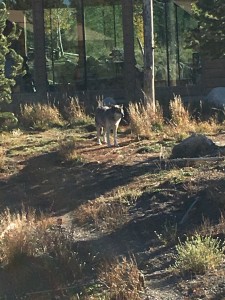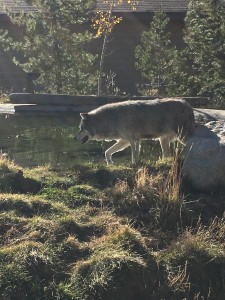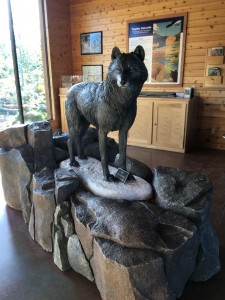
Wolves popular with Yellowstone visitors
WEST YELLOWSTONE, Mont. — Wolves have roamed the Earth for about 750,000 years. They inspire awe and fear at the same time and are one of the most mesmerizing predators to date. These animals have something special about them. Maybe its that deep, penetrating look in their eyes or how they roam the world so effortlessly but yet efficiently.
Many people are fearful of wolves as they are hunters. But, in Yellowstone National Park, more people have been attacked by bison than wolves.
“The interactions with wolves and people occur mostly outside of the national park. We’ve had more incidents of people getting attacked or even killed by bison than wolves,” said park spokesperson Amy Bartlett.
Yellowstone was established as the first national park in the United States in 1872. At this time, the gray wolf was already in decline in Montana, Idaho and Wyoming. By 1926, the gray wolf was completely extinct from this area due to government predator control programs. Although locals reported wolf sightings, scientists confirmed that wolves had been completely eliminated from Yellowstone by the mid-1900s.
About 20 years later, park employees, environmentalists, conservationists and some biologists began a campaign to reintroduce the gray wolf back into Yellowstone. The Endangered Species Act of 1973 was passed and wolves were slowly brought back to Yellowstone.
Lamar Valley, where visitors can also find bison, was the first location where the wolves gathered after being reintroduced. Between 1995 to 1997, 41 wild wolves from Canada and northwest Montana were released in Yellowstone National Park.
| A wolf at the Discovery Center near Yellowstone National Park (Photos by Melissa Soto). |  |
During the first year of their reintroduction, the wolf population grew quite rapidly.
While numbers increased, so did disease. Outbreaks of canine distemper occurred in 2005, 2008, and 2009. The outbreak in 2006 killed two-thirds of the pups inside the park. Other diseases such as canine parvovirus, bordetella and infectious canine hepatitis have also been confirmed in Yellowstone throughout the time these wolves were reintroduced.
Lamar Valley is not the only place to see wolves. Visitors can also drive to Mammoth Hot Springs, Mt. Washburn and Hayden Valley to potentially catch a glimpse of this unique animal.
At the moment there are less than 100 gray wolves in Yellowstone. Other than the areas mentioned above, wolves are most commonly seen in forests and meadows during dawn and dusk.
Wolves are very social animals and spend their days in packs.
In Yellowstone, the average pack size is 10 individuals which include an alpha male and alpha female along with subordinates. These intuitive creatures are known for defending their territory by howling or scent marking with urine.
A wolf’s diet consists of a variety of prey although elk is what they normally kill, especially during the winter. They spend the summer feasting on deer and bison.
Although seeing wolves inside Yellowstone National Park is ideal, it may not always be the case. Just outside of the park is the Grizzly & Wolf Discovery Center here, where wolves, bears and birds of prey can be viewed.
This Discovery Center is home to six incredible wolves. McKinley and his brother Leopold are part of the High Country Wolf Pack.
| A gray wolf explores its pen at West Yellowstone’s Discovery Center. |  |
Akela and Kootenai are from the River Valley Wolf Pack and Adara and Summit make up part of the Granite Wolf Pack.
Ken Brunson, a visitor from Alabama was admiring the High Country wolves.
“When I was in Yellowstone I didn’t see any wolves. I wanted to see them along with other animals so I decided to come to the Discovery Center,” said Brunson.
Trent Redfield, an animal expert at the center, shed some light on the wolves.
“Pups are born under the care of the alpha mother and other pack members,” said Redfield.
Redfield continued to explain their paths as they grow.
“After moving them from the den where they are born, the mother moves to rendezvous sites and they do their hunting in packs. These animals are quite unsocial in small groups or individually. They like to be in large groups. By the time they are two, these wolves have fully matured,” said Redfield.
 |
A gray wolf statue in the exhibits area of the Discovery Center. |
Wolves are extremely territorial. There have been cases were wolves kill each other in competition of territory disputes.
Every year park researchers catch a few of them and add radio tracking collars. By doing this, researchers are able to obtain new data on that individual wolf or even see how they interact with others.
The Yellowstone National Park Resources and Issues Handbook 2015 stated that, at the end of each year, only 20 percent of the population is collared.
Thankfully, the gray wolves and their reintroduction has helped balance the park’s ecosystem. Without them, animals and nature were declining. Yellowstone National Park has become a prime location for scientists to study the wilderness and focus on the ecosystem recovery.
If You Go
- Yellowstone National Park is located in Wyoming, Montana and Idaho
- Grizzly & Wolf Discovery Center: 201 S. Canyon St, West Yellowstone, Mont., 59758
- Phone Number: 406-646-7001
- Rates: Adult 13+ is $11.50, Seniors 62+ is $10.75, Children 5-12 is $6.50 and Children 4 and under are free
- Parking is free
- Visa, MasterCard, American Express and Discover cards are taken at the gift shop
- There is an ATM machine at the center
- Hours of Operation: Mondays through Sundays, 8:30 a.m. to 4 p.m.

Comments are Closed